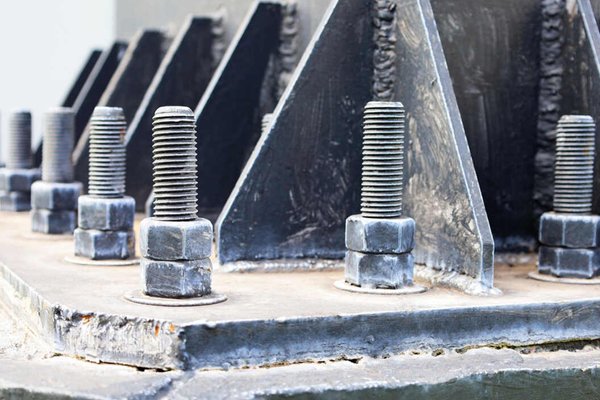
(+91) 82706 58519
Customer Care Number
info@technychemy.in
Email address
Tiruchirapalli, IN
Address location
Customer Care Number
Email address
Address location


Anchors and joints are essential components in construction that facilitate the secure connection between different structural elements. Anchors are used to fix structural and non-structural elements to concrete, masonry, or other substrates, providing stability and load-bearing capacity. Joints, on the other hand, are designed to accommodate movement, prevent cracking, and ensure that different parts of a structure can expand, contract, or shift without compromising overall stability.

Techny Chemy offers a wide range of anchors and joints products tailored to meet various construction needs:
These include expansion bolts, wedge anchors, and sleeve anchors, which provide a strong and reliable connection for heavy loads in concrete and masonry.
Epoxy-based and resin-based anchors that offer superior bonding strength, especially in challenging conditions, such as seismic zones or underwater applications.
Flexible joints designed to absorb movement caused by temperature changes, seismic activity, or settling of the structure, preventing cracks and damage.
Used to create deliberate weak points in concrete structures, control joints prevent random cracking by allowing controlled movement.
These joints are placed between different pours of concrete, ensuring that the structure remains cohesive and strong as it expands and contracts.

Anchors and joints are crucial in various special applications, including:
Seismic Zones
In earthquake-prone areas, anchors and joints provide the necessary flexibility and strength to withstand seismic forces, ensuring the safety of the structure.
Bridges and Highways
Expansion and control joints are essential in accommodating the movement caused by temperature fluctuations and heavy traffic, preventing cracks and structural damage.
High-Rise Buildings
Mechanical and chemical anchors are used to secure facades, curtain walls, and other elements in high-rise constructions, ensuring they remain stable and secure.
Industrial Facilities
In environments with heavy machinery or dynamic loads, anchors and joints ensure that structural elements remain securely fastened and capable of withstanding stress.
Marine Structures
Special chemical anchors and joints are used in marine environments to prevent corrosion and ensure long-term durability in harsh conditions.
Anchors and joints are indispensable across various industries, including:
Ensuring the stability and durability of residential, commercial, and industrial buildings.
Providing secure connections and accommodating movement in bridges, highways, tunnels, and dams.
Protecting pipelines, platforms, and storage facilities from dynamic loads and environmental stresses.
Safeguarding piers, docks, and offshore structures from corrosion and movement caused by waves and tides.
Ensuring the stability of heavy equipment and machinery, as well as the structures that house them.
Anchors ensure that various components of a structure remain securely in place, even under heavy loads or environmental stress.
Joints allow for controlled movement, preventing cracks, leaks, and other forms of damage that could compromise the integrity of the structure.
By providing secure connections and accommodating movement, anchors and joints contribute to the long-term durability of buildings and infrastructure.
Techny Chemy’s range of anchors and joints products is suitable for a wide variety of applications, from residential construction to large-scale industrial projects.
Properly installed anchors and joints ensure that structures can withstand external forces, reducing the risk of structural failure and enhancing overall safety.

With over three decades of experience, Techny Chemy is a trusted name in the construction chemical industry. Our anchors and joints products are developed through rigorous research and testing, ensuring they meet the highest standards of performance and reliability. We offer customized solutions to meet the specific needs of your projects, backed by our commitment to innovation, quality, and customer satisfaction.
Choose Techny Chemy for anchors and joints that provide unparalleled stability, durability, and safety for your structures. Trust in our expertise to deliver solutions that stand the test of time and ensure the success of your construction projects.
With 30 years of experience in the chemical industry, our team of experts is equipped to offer customized solutions tailored to your specific needs.
We are committed to sustainability, offering eco-friendly solutions that are safe for both the environment and users.
Our solutions are formulated using cutting-edge technology to provide maximum protection against water and moisture infiltration.
Anchoring is used to securely attach structural elements, such as beams, columns, or facades, to a concrete or masonry substrate. It ensures that these elements remain stable and can bear the required loads without movement or failure.
Common types include chemical anchors (epoxy or resin-based), mechanical anchors (such as expansion bolts, wedge anchors, and sleeve anchors), and undercut anchors, each designed for specific applications and load capacities.
Chemical anchors bond to the substrate using a resin or epoxy, providing superior strength and load-bearing capacity, while mechanical anchors rely on physical expansion within the substrate to secure the attachment.
Expansion joints are designed to accommodate movement in structures caused by temperature changes, seismic activity, or settling. They prevent cracks and structural damage by allowing controlled movement.
The choice depends on the type of movement expected (thermal, seismic, etc.), the materials used in construction, and the specific environmental conditions of the project.
Yes, seismic-rated anchors are specifically designed to withstand the forces generated during an earthquake, ensuring the safety and stability of the structure.
Materials such as rubber, silicone, metal, and composite materials are commonly used, chosen for their flexibility, durability, and ability to accommodate movement in the structure.
Without expansion joints, structures are at risk of cracking, warping, or even structural failure due to the inability to accommodate movement, leading to costly repairs and potential safety hazards.